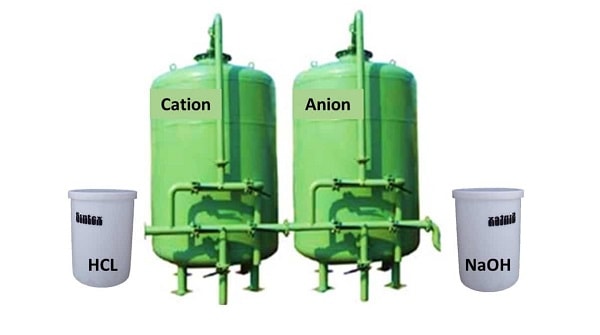DM Plant - Deminerlization Plant
A DM plant, also known as a demineralization plant or deionization plant, is a water treatment system design to remove dissolve minerals and salts from water, producing high-quality demineraliz water. DM plants are commonly use in various industrial processes, laboratories, power plants, and other applications where pure water is requir.
System Components
Pre-Treatment : Prior to entering the DM plant, water often undergoes pre-treatment processes to remove suspend particles, organic matter, and chlorine. Pre-treatment may involve processes such as sedimentation, filtration, activated carbon adsorption, and disinfection.
Cation Exchange Unit: The cation exchange unit is the first stage of the DM plant and contains a bed of cation exchange resin. The resin beads in this unit exchange positively charged ions (cations) present in the water, such as calcium, magnesium, sodium, and potassium ions, with hydrogen ions (H+). This process reduces the concentration of cations in the water.
Anion Exchange Unit: The anion exchange unit follows the cation exchange unit and contains a bed of anion exchange resin. The resin beads in this unit exchange negatively charge ions (anions), including chloride, sulfate, bicarbonate, and nitrate ions, with hydroxyl ions (OH-). This process reduces the concentration of anions in the water.
Mixed Bed Unit: After the cation and anion exchange units, some DM plants include a mixed bed unit. The mix bed unit consists of a mixture of cation and anion exchange resins in a single vessel.
Regeneration: Over time, the cation and anion exchange resins become exhaust and require regeneration to restore their capacity. Regeneration involves passing regenerant chemicals, such as hydrochloric acid (HCl) for cation resin and sodium hydroxide (NaOH) for anion resin, through the resin beds to remove the adsorb ions.
Polishing Treatment: This can involve processes like activated carbon filtration, ultrafiltration, or reverse osmosis to remove any residual impurities and achieve the desired water purity level.
Significance & Advantages
The output of a DM plant is typically demineralized water, which has a very low concentration of dissolved minerals and salts. Demineralize water is commonly used in various industrial processes, including boiler feedwater, cooling towers, pharmaceutical production, electronics manufacturing, laboratory applications, and more, where precise water quality and purity are essential.
Regular maintenance, including resin regeneration, monitoring of water quality, and occasional resin replacement, is necessary to ensure the continue performance and efficiency of a DM plant.






